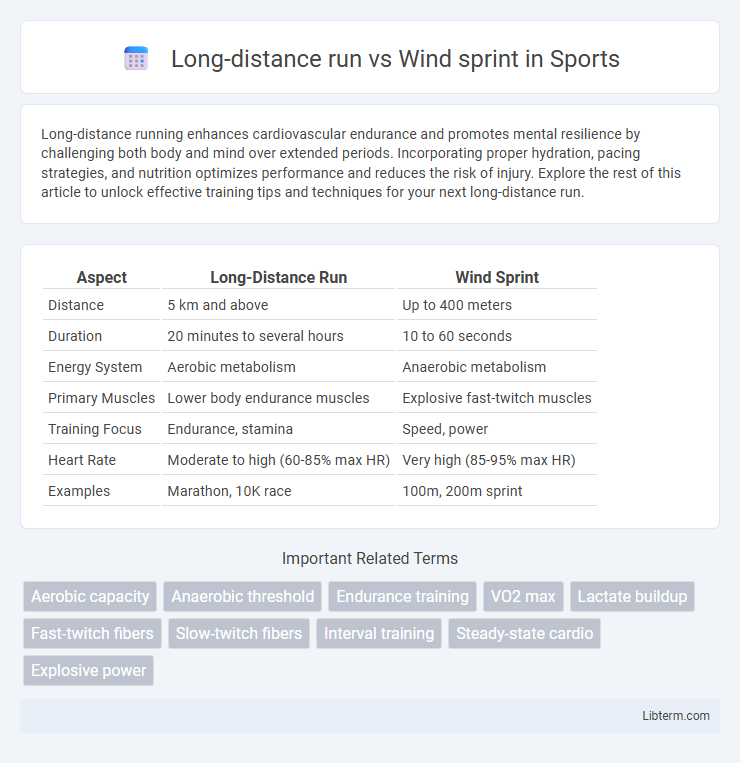Long-distance running enhances cardiovascular endurance and promotes mental resilience by challenging both body and mind over extended periods. Incorporating proper hydration, pacing strategies, and nutrition optimizes performance and reduces the risk of injury. Explore the rest of this article to unlock effective training tips and techniques for your next long-distance run.
Table of Comparison
| Aspect | Long-Distance Run | Wind Sprint |
|---|---|---|
| Distance | 5 km and above | Up to 400 meters |
| Duration | 20 minutes to several hours | 10 to 60 seconds |
| Energy System | Aerobic metabolism | Anaerobic metabolism |
| Primary Muscles | Lower body endurance muscles | Explosive fast-twitch muscles |
| Training Focus | Endurance, stamina | Speed, power |
| Heart Rate | Moderate to high (60-85% max HR) | Very high (85-95% max HR) |
| Examples | Marathon, 10K race | 100m, 200m sprint |
Introduction to Long-Distance Runs and Wind Sprints
Long-distance runs emphasize endurance by covering extended distances, typically ranging from 5 kilometers to marathon lengths, promoting cardiovascular health and aerobic capacity. Wind sprints focus on short bursts of maximum speed over distances of 20 to 100 meters, enhancing anaerobic power and fast-twitch muscle activation. Both training methods uniquely contribute to overall athletic performance by targeting distinct energy systems and muscle fibers.
Key Differences Between Long-Distance Runs and Wind Sprints
Long-distance runs emphasize aerobic endurance by maintaining a steady pace over extended distances, enhancing cardiovascular efficiency and muscular stamina. Wind sprints concentrate on anaerobic power, involving short bursts of maximum speed to improve fast-twitch muscle fibers and explosive strength. Key differences include energy system utilization, muscle engagement, duration, and recovery times, with long-distance running relying on oxygen intake and wind sprints depending on immediate energy reserves.
Physiological Demands of Each Training Method
Long-distance running primarily stresses the aerobic energy system, enhancing cardiovascular endurance and increasing mitochondrial density for sustained energy production. Wind sprints rely on the anaerobic energy system, promoting fast-twitch muscle fiber activation, rapid ATP turnover, and elevated lactate tolerance. Both training methods improve muscular strength and endurance but target distinct physiological adaptations crucial for different athletic performance goals.
Muscle Groups Activated: Endurance vs. Power
Long-distance running primarily activates slow-twitch muscle fibers in the lower body, emphasizing endurance by enhancing aerobic capacity and muscular stamina. Wind sprints engage fast-twitch muscle fibers, promoting explosive power and strength in the glutes, quadriceps, hamstrings, and calves. These contrasting muscle activations reflect the distinct physiological demands of prolonged aerobic exertion versus short, high-intensity anaerobic bursts.
Cardiovascular Benefits: Long-Distance vs. Sprinting
Long-distance running enhances cardiovascular endurance by promoting efficient oxygen delivery and increasing heart stroke volume through sustained aerobic activity. Wind sprints improve cardiovascular health by boosting anaerobic capacity, elevating heart rate in short bursts, and enhancing overall cardiac output. Both training methods contribute to heart health, but long-distance running targets endurance while sprinting emphasizes explosive cardiovascular power.
Impact on Weight Loss and Body Composition
Long-distance running primarily enhances fat oxidation and improves cardiovascular endurance, making it effective for sustained calorie burning and gradual fat loss. Wind sprints, or high-intensity interval training (HIIT), trigger significant post-exercise oxygen consumption (EPOC), which accelerates metabolism and promotes lean muscle retention during weight loss. Combining both exercises optimizes body composition by maximizing fat loss while preserving or increasing muscle mass through varied intensity levels.
Injury Risks and Prevention Strategies
Long-distance running primarily poses risks of overuse injuries such as shin splints, stress fractures, and tendonitis due to repetitive motion and prolonged impact on joints. Wind sprints increase the risk of acute injuries like hamstring strains, muscle pulls, and ligament tears because of sudden acceleration and explosive muscle contractions. Preventative measures for both include proper warm-up routines, strength training targeting vulnerable muscle groups, and gradual progression in training intensity to enhance resilience and reduce injury incidence.
Suitable Sports and Athletic Goals
Long-distance running is highly suitable for endurance sports such as marathons, triathlons, and cross-country, promoting cardiovascular stamina and efficient oxygen utilization. Wind sprints excel in explosive power sports like soccer, basketball, and track events requiring rapid acceleration and short bursts of speed. Athletes aiming to enhance aerobic capacity should prioritize long-distance running, while those targeting anaerobic performance and fast-twitch muscle activation benefit more from wind sprint training.
How to Incorporate Both into Your Training Routine
Incorporate long-distance runs to build aerobic endurance and wind sprints to enhance anaerobic power and speed within your training routine by alternating sessions throughout the week to balance recovery and intensity. Schedule long-distance runs on low-intensity days to improve cardiovascular capacity, while dedicating separate days to high-intensity wind sprints with adequate warm-ups and cool-downs to prevent injury. Use periodization techniques, such as tapering sprint volume before races, to optimize performance and ensure sustained progress across both energy systems.
Conclusion: Choosing the Right Method for Your Goals
Long-distance running enhances aerobic endurance, supporting sustained cardiovascular health and fat metabolism, making it ideal for improving stamina and overall fitness. Wind sprints boost anaerobic capacity, muscle power, and fast-twitch fiber development, optimizing performance in explosive activities and short bursts of speed. Selecting the right training method depends on specific goals such as endurance building versus speed enhancement, ensuring alignment with desired physiological adaptations.
Long-distance run Infographic

 libterm.com
libterm.com